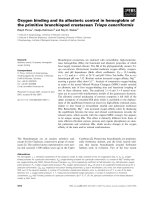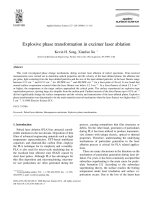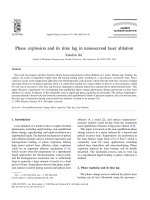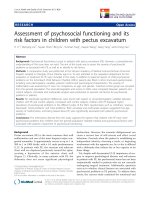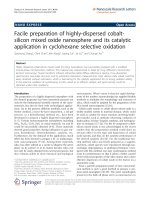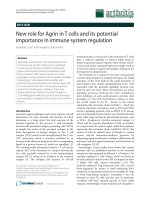phase explosion and its time lag in nanosecond laser ablation
Bạn đang xem bản rút gọn của tài liệu. Xem và tải ngay bản đầy đủ của tài liệu tại đây (154.38 KB, 6 trang )
Phase explosion and its time lag in nanosecond laser ablation
Xianfan Xu
*
School of Mechanical Engineering, Purdue University, West Lafayette, IN 47907-1288, USA
Abstract
This work investigates interface kinetics during nanosecond pulsed excimer ablation of a metal. During laser heating, the
surface can reach a temperature higher than the normal boiling point, resulting in a superheated, metastable state. Phase
explosion occurs as the temperature approaches the thermodynamic critical point, which turns the melt into a mixture of liquid
and vapor. However, for phase explosion, there is a certain time needed for a vapor embryo to grow to a critical nucleus, called
the time lag of nucleation. This time lag becomes important in ablation induced by nanosecond or shorter pulsed lasers. This
paper discusses experiments for investigating non-equilibrium phase change phenomena during nanosecond excimer laser
ablation of a metal. Evidences of the metastable state in liquid and phase explosion are presented. The surface temperature–
pressure relation is found to deviate from the commonly used equilibrium Clausius–Clapeyron equation. Also, for the first time,
the time lag of nucleation during nanosecond laser ablation is found to be around 5 ns.
# 2002 Elsevier Science B.V. All rights reserved.
Keywords: Non-equilibrium phase change; Phase explosion; Time lag; Laser ablation
1. Introduction
Laser ablation of a metal involves complex thermal
phenomena, including rapid heating, non-equilibrium
phase change, superheating, and rapid nucleation in a
superheated liquid. The thermal mechanisms of pulsed
laser ablation include surface normal evaporation and
homogeneous boiling, or phase explosion. During
high power pulsed laser ablation, phase explosion
could be an important ablation mechanism [1–4],
which occurs when the temperature of a superheated
liquid approaches the thermodynamic critical point,
and the homogeneous nucleation rate is sufficiently
large to generate a large amount of nuclei in a short
period of time. Experiments showed that phase explo-
sion indeed occurred during nanosecond pulsed laser
ablation of a metal [2], and surface temperature–
pressure relation could deviate from the commonly
used equilibrium Clausius–Clapeyron relation [5,6].
This paper is focused on the non-equilibrium phase
change process in a metal induced by a nanosecond
pulsed excimer laser. Experiments are performed in
the laser fluence range from 2.5 to 9 J/cm
2
, which is
commonly used for many applications including
pulsed laser deposition and micromachining. Phase
explosion induced by laser heating will be briefly
described. The nucleation process and its time lag
in a superheated liquid leading to phase explosion is
studied.
2. Phase explosion and its time lag
The phase change process induced by pulsed laser
heating can be best illustrated using the pressure—
Applied Surface Science 197–198 (2002) 61–66
*
Tel.: þ1-765-494-5639; fax: þ1-765-494-0539.
E-mail address: (X. Xu).
0169-4332/02/$ – see front matter # 2002 Elsevier Science B.V. All rights reserved.
PII: S 0169-4332(02)00304-5
temperature diagram shown in Fig. 1. The ‘normal
heating’ indicates heating of a liquid metal when the
temperature is below the boiling temperature. The
binode line represents equilibrium between the surface
temperature T and the vapor saturation pressure p
s
,
which is calculated from the Clausius–Clapeyron
equation:
p
s
¼ p
0
exp
H
lv
ðT À T
b
Þ
RTT
b
(1)
where p
0
is the ambient pressure, H
lv
the enthalpy of
vaporization, and T
b
the equilibrium liquid–vapor
temperature at the ambient pressure. During high
power pulsed laser heating, it is possible to heat a
liquid metal to temperatures above the boiling point
while the surface vapor pressure is not built up as
rapidly. The liquid is then superheated, i.e., its tem-
perature is higher than the vaporization temperature
corresponding to its surface pressure. In this case, the
heating process follows a superheating line shown in
Fig. 1, and the liquid is in a metastable state.
There is an upper limit for superheating of a liquid,
the spinode [7], which can be obtained from a calcula-
tion of the nucleation rate using the Do
¨
ring and
Volmer’s theory [8,9]:
J ¼ N
3s
pm
1=2
exp
ÀW
cr
k
B
T
(2)
where W
cr
is the energy needed to form critical vapor
nuclei at temperature T, N the number of liquid
molecules per unit volume, and s the surface tension.
According to Eq. (2), the spontaneous nucleation rate
increases exponentially with temperature. During
pulsed laser heating, the amount of nuclei generated
by spontaneous nucleation is negligible at tempera-
tures lower than 0.9T
c
. At a temperature of about
0.9T
c
, a significant number of nuclei can be formed.
Hence, explosive phase change occurs, which turns
the liquid into a mixture of liquid and vapor.
One important factor in analyzing phase change
induced by pulsed laser heating is the time required for
a vapor embryo to grow to a critical nucleus. This time
is also called the time lag for nucleation. The time lag
must be considered in pulsed laser ablation since it is
on the same order of the laser pulse duration. Eq. (2)
can be modified to account for this time lag, t, which
can be expressed as
J ¼ N
3s
pm
1=2
exp
ÀW
cr
k
B
T
exp
Àt
t
(3)
where t is the time duration for which the liquid is
superheated. The time lag t has been estimated to be
[9]
t %
2pM
RT
1=2
4psp
s
ðp
s
À p
l
Þ
2
(4)
where M is the molar weight of the substance. For
metals, the time lag was estimated to be between 1 and
10 ns [9].
3. Experimental investigation
3.1. Experiments and results
A KrF excimer laser with a wavelength of 248 nm
and a pulsewidth of 25 ns (FWHM) is used in the
experiments. Transient transmissivity of laser beam
through the laser-induced vapor plume, scattering of
laser beam from the laser-induced vapor plume, tran-
sient location and velocity of the laser-induced vapor
front, and ablation depth per laser pulse are measured.
Ni is used as the target. Details of the experiments
have been given elsewhere [3]. A summary of the
results is shown in Fig. 2.
Fig. 2a shows the percentage of laser energy scat-
tered from the vapor plume. It is seen that there is
Fig. 1. The p–T diagram of a liquid metal near the critical point.
62 X. Xu / Applied Surface Science 197–198 (2002) 61–66
almost no scattering (less than 0.5%, the measurement
resolution) in the low laser fluence region. When the
laser fluence is higher than 5.2 J/cm
2
, the percentage
of laser energy scattered by the plume is increased to
about 4–5%. Fig. 2b shows the ablation depth per laser
pulse at different laser fluences. The ablation depth
increases from 14 to 20 nm when the laser fluence is
less than 4.0 J/cm
2
. When the laser fluence increases
from 4.2 to 5.2 J/cm
2
, a jump increase in the ablation
depth is observed, and stays relatively a constant at
higher laser fluences. Fig. 2c shows the averaged
velocity of the laser-evaporated vapor. It is seen that
the vapor velocity increases with the laser fluence. A
sudden jump of the velocity is seen at the laser fluence
of 4.2 J/cm
2
. In the laser fluence range between 5.2
and 9 J/cm
2
, the velocity is almost a constant. Fig. 2d
shows the transient transmissivity of the vapor at
different laser fluences. The transmissivity is almost
identical when the laser fluence is higherthan 5.2 J/cm
2
,
which is exactly the same fluence region in which the
velocity of the vapor changes little.
These phenomena are explained as a result of phase
explosion occurring at laser fluence around 5 J/cm
2
.
Scattering of laser energy is due to large size (on the
order of sub-micron or larger) droplets in the vapor
plume instead of (atomic) vapor (note that scattering is
not due to the ignition of plasma, since plasma is
observed at fluences lower than 5 J/cm
2
). Therefore,
there are no droplets in the vapor plume at low fluences,
the materials removal is due to surface evaporation.
This is also confirmed by collecting evaporated mate-
rial using a glass slide at about 1 cm above the target, at
laser fluences below and higher than 5 J/cm
2
. At high
fluences, droplets are generated due to phase explosion,
which cause scattering. For the ablation depth, when
explosive phase change occurs, the melted layer is
turned into a liquid–vapor mixture. Therefore, the
increase of the ablation depth at the laser fluence of
5.2 J/cm
2
also indicates the transition from surface
evaporation to phase explosion.
The velocity of the vapor plume is determined
by the pressure and the temperature at the surface.
Fig. 2. (a) Percent of laser energy scattered to the ambient, (b) ablation depth, (c) vapor velocity, and (d) transient transmissivity of vapor as a
function of laser fluence.
X. Xu / Applied Surface Science 197–198 (2002) 61–66 63
The constant velocity at high laser fluences indicates
that the surface temperature is not affected by the
increase of laser fluence. Such a constant surface
temperature can be explained as a result of phase
explosion. As discussed earlier, the surface tempera-
ture during phase explosion is about 0.9T
c
. For the
transmission data, extinction of the laser beam is
determined by the cross-section of the energized
atoms, which in turn is determined by the temperature
of the vapor plume. Thus, the transmission data also
indicate the occurrence of phase explosion.
Therefore, these four independent experiments all
demonstrate that surface evaporation occurs at laser
fluences below 4 J/cm
2
, and phase explosion takes place
when the laser fluence is higher than about 5 J/cm
2
.
3.2. Interface superheating and the time
lag of nucleation
The pressure at the evaporating surface is needed to
understand the evaporation kinetics, which is mea-
sured with the use of a PVDF transducer [10].Of
particular interest is the pressure when phase explo-
sion occurs (at 5.2 J/cm
2
), which is determined to be
about 600 bar. Fig. 3 shows the Clausius–Clapeyron
equation for Ni, together with the experimental data
point at 5.2 J/cm
2
. It can be seen that the measured
pressure is well below the equilibrium pressure, show-
ing that the liquid is in a superheated state. The
equilibrium surface temperature–pressure relation is
not valid for pulsed laser ablation.
The validity of the equilibrium evaporation kinetics
is also examined by computing the evaporation depth
from the measured pressure using the Clausius–
Clapeyron equation, Eq. (1), and comparing it with
the measured data. The transient surface temperature T
is first calculated from the measured transient surface
pressure p using Eq. (1). From T and p, the evaporation
velocity, V
lv
can be calculated from
V
lv
¼
mp
s
r
l
ð2pmk
B
TÞ
1=2
(5)
The ablation depth per laser pulse is then obtained by
integrating the evaporation velocity over time. The
calculated ablation depths are shown in Fig. 4. It can
be seen that the calculated values are much larger than
the measured data. This large discrepancy again indi-
cates that the equilibrium interface kinetics is not valid
during nanosecond pulsed laser evaporation.
Fig. 2d reveals another phenomenon, that the onset
of ablation, which can be obtained from Fig. 2d as the
time when transmission starts to decrease, is about the
same at laser fluences higher than the threshold for
phase explosion. The onset of ablation is also deter-
mined from the measured position of the vapor front
vs. time (which is measured using the optical deflec-
tion technique [3] and is used to obtain the velocity of
the vapor front) shown in Fig. 5. The onset of ablation
obtained using these two methods is shown in Fig. 6a
and b. Both figures show that, when the laser fluence is
higher than 5.2 J/cm
2
, the onset of ablation does not
Fig. 3. Comparison between the Clausius–Clapeyron relation and
the measured pressure at 0.9T
c
.
Fig. 4. Comparison between the measured ablation depth and the
values calculated using transient pressure data and the equilibrium
kinetic relation.
64 X. Xu / Applied Surface Science 197–198 (2002) 61–66
change with the laser fluence, but remains at around
5.5 ns. The two independent measurements provide
almost identical results. The constant onset of ablation
at laser fluences higher than 5.2 J/cm
2
can be
explained in terms of the time lag for phase explosion.
As discussed previously, before phase explosion can
take place, there is a certain time needed for a vapor
embryo to grow to a critical nucleus. The constant
onset at laser fluences higher than the threshold of
phase explosion shows that the time lag of nucleation
has prevented phase explosion to occur at an earlier
time when the laser fluence is increased; and this time
lag, according to the experimental data, is about
5.5 ns.
One interesting issue is what would occur if the
laser pulsewidth is much shorter than the time lag of
nucleation. Many experiments have shown the thresh-
old nature of sub-nanosecond laser ablation [11,12],
and phase explosion was explained as the ablation
mechanisms [13]. However, given the time lag much
longer than the pulsewidth, detailed studies are needed
to gain a thorough understanding of ablation mechan-
ism in a pico- or femtosecond laser ablation.
4. Conclusions
Non-equilibrium phase change during nanosecond
pulsedexcimerlaser ablation of nickel wasinvestigated.
Results of experiments showed surface evaporation
Fig. 5. Transient location of the vapor front as a function of laser fluence.
Fig. 6. Onset of evaporation as a function of laser fluence
determined from (a) the transient transmissivity through the vapor,
and (b) the transient location of the vapor front.
X. Xu / Applied Surface Science 197–198 (2002) 61–66 65
occurred at laser fluences below 4 J/cm
2
, and phase
explosion occurred at the laser fluences higher than
5 J/cm
2
. The surface kinetic relation deviated signifi-
cantly from the equilibrium Clausius–Clapeyron
equation. The time lag of phase explosion during
excimer laser ablation of a nickel target was found
to be around 5.5 ns.
Acknowledgements
Support of this work by the National Science
Foundation and the Office of Naval Research is grate-
fully acknowledged.
References
[1] A. Miotello, R. Kelly, Appl. Phys. Lett. 67 (1995) 3535.
[2] K.H. Song, X. Xu, Appl. Surf. Sci. 127–129 (1998) 111.
[3] X. Xu, in: C L. Tien, F.P. Incropera, V. Prasad (Eds.), Annual
Review of Heat Transfer, Vol. 12, 2001, pp. 79–115.
[4] D.A. Willis, X. Xu, Int. J. Heat Mass Trans., in press.
[5] X. Xu, K.H. Song, Appl. Phys. A 69 (1999) S869.
[6] X. Xu, K.H. Song, Mater. Sci. Eng. A 292 (2000) 162.
[7] W. Fucke, U. Seydel, High Temperature High Pressure 12
(1980) 419.
[8] V.P. Carey, Liquid–Vapor Phase-change Phenomena: An
Introduction to the Thermophysics of Vaporization and
Condensation Processes in Heat Transfer Equipment, Hemi-
sphere, Washington, DC, 1992.
[9] V.P. Skripov, Metastable Liquids, Wiley, New York, 1974.
[10] K.H. Song, X. Xu, in: Proceedings of the 1998 ASME
International Mechanical Engineering Congress and Exposi-
tion, HTD-Vol. 361-4, American Society of Mechanical
Engineers, New York, 1998, p. 79.
[11] D.A. Willis, X. Xu, in: Proceedings of the 2000 International
Congress on Applications of Lasers and Electro-optics,
Vol. 90, Laser Institute of America, Orlando, FL, 2000,
p. A36.
[12] A. Cavalleri, K. Sokolowski-Tinten, J. Bialkowski, D. von der
Linde, Appl. Phys. Lett. 72 (1998) 2385.
[13] K. Sokolowski-Tinken, J. Bialkowski, M. Boing, A. Cavalleri,
D. von der Linde, Bulk, in: Proceedings of the Quantum
Electronics and Laser Science Conference, OSA Technical
Digest, Optical Society of America, Washington, DC, 1999,
p. 231.
66 X. Xu / Applied Surface Science 197–198 (2002) 61–66


